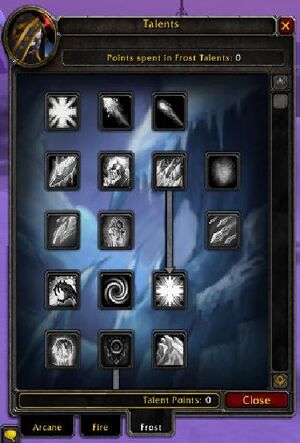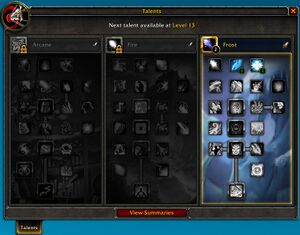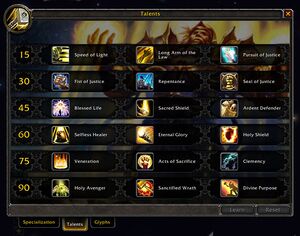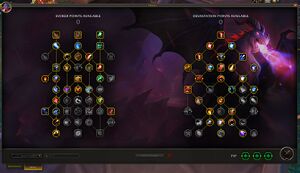Talent
| Classes | |||||||||||||
|---|---|---|---|---|---|---|---|---|---|---|---|---|---|
| Class races | DK | DH | Dr | Ev | Hu | Ma | Mo | Pa | Pr | Ro | Sh | Wl | Wr |
| Quests | DK | DH | Dr | Ev | Hu | Ma | Mo | Pa | Pr | Ro | Sh | Wl | Wr |
| Abilities | DK | DH | Dr | Ev | Hu | Ma | Mo | Pa | Pr | Ro | Sh | Wl | Wr |
| Trainers | DK | DH | Dr | - | Hu | Ma | Mo | Pa | Pr | Ro | Sh | Wl | Wr |
| Armor sets | DK | DH | Dr | Ev | Hu | Ma | Mo | Pa | Pr | Ro | Sh | Wl | Wr |
| Useful macros | DK | DH | Dr | - | Hu | Ma | Mo | Pa | Pr | Ro | Sh | Wl | Wr |
| Class Halls | DK | DH | Dr | - | Hu | Ma | Mo | Pa | Pr | Ro | Sh | Wl | Wr |
Talents are special abilities that can be chosen to augment your character. Talents may be passive bonuses or active abilities. Each class has two trees: one shared class tree, and one tree specific to the chosen specialization. Talents offer a further level of customization beyond class and specialization selection, and can be changed very easily and cheaply.
Full listings of the talents available to each class can be found on that class's abilities page, e.g.: Priest abilities.
Talents can be swapped at any time while in a rested area, or for a short time after queuing into an instanced dungeon, raid, or PvP content.
Gaining talents
Each class has both a class tree and a spec tree. One talent point is earned each level starting at level 10, alternating between the two trees.
Beginning in The War Within, an additional Hero Talent tree will be added as well. Hero trees are unique to each class, and each spec will have a choice of two trees.
Tips
- If you intend to participate in end-game PvE raid content, it is recommended to choose talents with the boss encounter in mind. For example, a talent that improves damage or survivability against the boss might be preferred over a talent that only improves damage or survivability against trash mobs. The raid will undoubtedly find the boss encounter more difficult, and preparing for it will aid in surpassing the challenge.
- While leveling, feel free to experiment with talents and choose that are the most handy or useful for you. Talent choices will likely differ at max level anyway, and in the mean time convenience and enjoyment is usually more important. In addition, leveling frequently involves participation in multiple types of play (questing, instances, PvP) and so it is unlikely that a single talent build will be ideal for all play, and it's usually uneconomical to reset them for each situation. However, be aware that when playing in groups, your talent choices may impact other players; if anticipating a tough encounter, you may wish to re-customize your choices accordingly.
History
Talents have gone through some very substantial changes over the years. The prime form of character augmentation and customization in World of Warcraft, talents were the predecessors of specializations, predating the introduction of fixed specializations by many years. Originally a complex and intricate system of possible combinations, since Wrath of the Lich King talents have been reduced and simplified, with many of their earlier functions being split off into other mechanisms. The original means of customizing your character's abilities and combat role, Cataclysm saw the creation of specific specializations, making the selection of a player's talents more helpful than critical, while Mists of Pandaria saw them converted to a far simpler system, with choice no longer determined by specialization or previous selections. While the current system features a fraction of the number of talents previously known, a large amount of talents have been converted into specialization-specific or class-wide abilities, with many key abilities having started life in the higher tiers of a class's pre-historic talent trees.
Classic talent trees
Originally, each class's talents were presented in three talent trees. Talents were presented in three separate trees, with access to the higher or deeper tiers of each tree granted only through selecting sufficient talents in that tree. Talent trees were the original form of class specializations, with a player's choice of talents often determining which combat role they were fit to perform.
Talent points were granted to players as they leveled, with talents selected by spending one of the player's points. Spending sufficient talent points in a given tier granted access to the next tier. Most talents had multiple ranks, with players often having to spend 5 points in a talent to gain its total effect, and the majority of all talents were passive, with the few active talents in each tree usually powerful and desirable abilities. By Wrath of the Lich King, max-level characters had 71 talent points to spend, with 11 tiers in each tree and more than 80 talents to choose from. The many ranks available for most talents presented some classes with more than 230 possible places to spend their points, and myriad ways of building their character's spec.
Talent trees created a focused, limiting relationship with talents, with some of the most powerful talents placed deep within their trees, meaning only players who chose to spend the vast majority of their points in that tree were able to acquire them. Conversely, some talents that were useful to players of all kinds were made available on the lower tiers. This can be seen to have forced players to focus on their chosen priorities, with every choice of talent affecting all future options, and every unlocked tier in one tree meaning a lost tier of talents in another. Some talents also required the choice of specific talents earlier in the tree.
Because talent choice was therefore cumulative and limiting, the term "talent build" or simply "build" was used to describe the total combination and emphasis of a character's talent choices (and to a lesser degree other enhancements). A player's spread of points across their trees was expressed numerically, such as (10/0/61) for a tanking warrior specced deep into the Protection tree, or (0/37/34) for a druid balancing healing with survival. Players could choose to spec deep into a certain tree, focusing on improving their abilities in that particular area; or to balance that focus with varying amounts of talents from other trees, perhaps gaining crucial secondary-role abilities and avoiding over-specializing. Some players chose to create true hybrid builds, such as mages combining Frost and Fire talents. Choice of talents held a significant amount of complexity, with numerous online calculators and recommended builds, and constant debate over the best combinations.
A common approach was for players to spend enough points in a tree to reach the top talent, usually an extremely powerful ability that was therefore only available to players who specialized fully in that tree, before spending their remaining points in the often more desirable talents of another tree. Many talents were considered to be "filler" talents, granting little benefit but being placed in such a position that taking them was required in order to gain access to higher tiers or other particularly desirable talents. Choice of talents was often focused upon access to certain key abilities, with builds designed to hit these talents while spending as few points as possible on less desirable options. Once these key points were decided upon, the choice of build often became a matter of which of the less desirable options were preferred (or at least which were the least useless), since a certain number of them had to be chosen.
A player's selection of talents was intended to be binding and difficult to reverse. Talents could only be reset by visiting a class trainer, and the amount of gold required to do so was substantial, and rose with each reset. Players wishing to change spec, such as a DPS-oriented warrior wishing to tank in a dungeon, would have to spend time and money seeking the services of a trainer, while even players who often played in different roles had to spend substantial amounts of money switching between different talent builds. Players therefore often chose their talents with an expectation of permanence; players wishing to participate in PvP as they leveled, or wishing to run dungeons as healers while still being capable of dealing a reasonable amount of damage, would have to make numerous compromises in their builds, as respeccing was both a costly and time-consuming act. For this reason Dual Talent Specialization was introduced in patch 3.1.0, for the then-princely sum of 1000![]() , making it possible for the first time to switch between two sets of talents.
, making it possible for the first time to switch between two sets of talents.
Cataclysm
Cataclysm introduced an explicit choice of specialization, creating three fixed specs for each class with a pre-determined combat role. Talents continued to be significant choices, but were no longer so critically responsible for determining the player's capabilities. With this change, many core abilities that had once been talents--especially ones deep in the trees--became automatically acquired by choosing a specialization. Additionally, the trees were condensed in size from 11 rows to 7. Dozens of talents were removed, while others saw their number of ranks reduced. The number of available talent points was reduced accordingly from 71 to 41.
With the introduction of specializations, talent trees became locked, with only the tree corresponding to a character's chosen specialization being initially available for selection. By spending 31 points in their primary tree players were able to unlock their other trees, and could then spend any remaining points as they wished. However, because of the progressive nature of the trees, this limited players to relatively insignificant talents from their secondary trees, with enough points to access the second tier of only one of their secondary trees. This was intended, serving to allow Blizzard to focus on creating three separate and distinct specs for each class, with the aim of improving balance and deepening and refining the character and playstyle of each spec, and was also argued by some to make the previously overly-complex talent trees far easier for new players to get to grips with.
These changes resulted in a far smaller degree of choice in talent selection, with each max-level spec capable of a relatively small number of possible builds. While players were still free to spend their last 10 points in any tree, some players bemoaned the loss of true hybrid specs from the game, with many previous combinations now made impossible. Additionally, while talents remained the source of many of players' most powerful abilities, due to the far more limited and rigid nature of the new talent trees, the total number of possible builds at max-level was greatly reduced, in turn reducing the importance of players' talent selections. As Blizzard would alter acknowledge in the lead-up to the next expansion, the Cataclysm model made players' choices far less significant, because once the most important talents had been secured, the question of where to spend their remaining points had relatively little impact on their character. In this way, the Cataclysm talent trees moved players closer to a "cookie-cutter" situation, with relatively little talent variation seen between most characters of a given spec.
Cataclysm also saw the level requirement of Dual Talent Specialization reduced from 40 to 30, and its price reduced from 1000![]() to a mere 100
to a mere 100![]() . This, coupled with the usual devaluation of gold following the increased level cap of a new expansion, made the option available to players far earlier. With such a low price, there was little reason for any player of sufficient level not to have purchased dual specialization, greatly increasing the numbers of players capable of switching between specs at a moment's notice, especially at lower levels.
. This, coupled with the usual devaluation of gold following the increased level cap of a new expansion, made the option available to players far earlier. With such a low price, there was little reason for any player of sufficient level not to have purchased dual specialization, greatly increasing the numbers of players capable of switching between specs at a moment's notice, especially at lower levels.
Mists of Pandaria
Mists of Pandaria saw the first complete overhaul of the talent system. Talent trees were removed entirely, replaced with six tiers of three talents each. Players were given the option of choosing a single talent from each tier, and choices in one tier no longer affected subsequent choices, removing most of the strategy from talent selection. Access to talents was also no longer limited by specialization, with many previous talents having been changed into specialization-specific abilities. Instead of earning talents points regularly when leveling up, the six tiers were instead unlocked at levels 15, 30, 45, 60, 75, and 90.
Mists of Pandaria also made it easier for players to change their talent selections using items such as ![]() [Tome of the Clear Mind]. For the first time players were able to adjust their own talents on the move, even mid-instance, rather than having to traipse back to their class trainers. As well as facilitating experimentation and variation, this change was also promoted as allowing for a far greater degree of versatility, with players able to change talents in order to meet the demands of a specific encounter, or catering to the strengths and weaknesses of the opposing team in PvP.
[Tome of the Clear Mind]. For the first time players were able to adjust their own talents on the move, even mid-instance, rather than having to traipse back to their class trainers. As well as facilitating experimentation and variation, this change was also promoted as allowing for a far greater degree of versatility, with players able to change talents in order to meet the demands of a specific encounter, or catering to the strengths and weaknesses of the opposing team in PvP.
As with any major change, the new talent system sparked much controversy and debate among players, with numerous threads devoted to the subject on the official forums. Many players felt that the new system stripped them of much of their choice by replacing dozens of talents with only a few, and forced them to choose between talents that were often considered equally undesirable. Some also considered the changes to the talent system to be a further simplification and a "dumbing down" of the game. Others argued that the new system in fact increased choice; while the previous system had presented dozens of talents to choose from, in practice most end-game players chose very similar builds, with little if any room for customization. Additionally, what differences were to be found were largely limited to where to place the last few points, and these choices were often considered to make little difference to the player's abilities. In contrast, the new system offered players far more choice, and far more significant choices, with most talents representing substantial differences to the player's abilities and playstyle, in spite of smaller set of options.
Warlords of Draenor
Warlords of Draenor further refined the talent model from Mists of Pandaria. The most significant systematic change was that some talent rows now dynamically changed based on the player's current specialization. For example, the second slot of the mage level 75 row contained ![]() [Unstable Magic] for all specializations, but the first and third slots contained
[Unstable Magic] for all specializations, but the first and third slots contained ![]() [Nether Tempest] and
[Nether Tempest] and ![]() [Supernova] for Arcane,
[Supernova] for Arcane, ![]() [Living Bomb] and
[Living Bomb] and ![]() [Blast Wave] for Fire, and
[Blast Wave] for Fire, and ![]() [Frost Bomb] and
[Frost Bomb] and ![]() [Ice Nova] for Frost. While Mists of Pandaria had a number of talents (such as
[Ice Nova] for Frost. While Mists of Pandaria had a number of talents (such as ![]() [Incarnation]) which changed function depending on the player's selected specialization, Warlords of Draenor actually presented wholly different options when the player changed specialization. This change made it easier to diversify talents without burdening tooltips, but also made it harder for players to inspect talents for alternate specs. For the first time, it was not possible to view each specialization's talents without going to the trouble of learning the spec, making the use of online talent calculators and listings more useful than before.
[Incarnation]) which changed function depending on the player's selected specialization, Warlords of Draenor actually presented wholly different options when the player changed specialization. This change made it easier to diversify talents without burdening tooltips, but also made it harder for players to inspect talents for alternate specs. For the first time, it was not possible to view each specialization's talents without going to the trouble of learning the spec, making the use of online talent calculators and listings more useful than before.
With the level cap raised to 100, Warlords of Draenor also introduced a seventh tier of talents, raising the new number of talents available to each spec to 21. However, due to differences in specialization-specific choices, the total number of talents per class varied, with classes such as rogue and death knight having only one set of 21 talents for the entire class, while druids featured several spec-specific options for a total of 33 talents. Most classes had between 21 and 26 talents.
Legion
While Legion did not significantly alter the talent system itself (indeed, it did not even add a new tier of talents at the new level cap), it did introduce one notable update by removing Dual Talent Specialization. Instead, all players had the option of switching freely between each specialization, with their talent selection for each one automatically saved when swapping. In a bit of synergy with the artifact system, the player's equipped artifact weapon would also be automatically switched when changing specializations.
Dragonflight
After five expansions with the Mists of Pandaria model, Dragonflight once again completely overhauled the entire system, bringing back the talent tree concept but with significant differences borne from modernization. According to Ion Hazzikostas, this system was largely inspired by seeing a new generation of players using traditional talent trees in Classic and realizing some things that the development team had "kind of lost" over the years.[citation needed]
Players now had access to two talent trees: one shared by the entire class, and one specific to their chosen specialization. Talent points were gained with every level, but each tree had its own pool of talent points, granted at alternating levels. Each tree had significantly more talent choices than the original iteration, though the vast majority now only had a single rank, with a much smaller number having two. Originally a tiny number of talents had three ranks, but almost all of these were reduced in Dragonflight's patches. While the original system required spending 5 points in each tier before moving to the next one, this new system allowed players to freely continue to any other linked talents, even if only a single point had been spent in a row. However, each tree had two gates: row 5 was locked until a total of 8 talent points had been spent in that tree, and row 8 was locked until a total of 20 points had been spent. This served largely to ensure that the most powerful talents could not be earned until the player had attained a sufficient level.
Pet talent points
Prior to patch 5.0.4, hunter pets enjoyed their own talent system, featuring trees in which hunters could spend each pet's talent points. The pet talent system was removed with Mists of Pandaria, with many talents removed, and the rest converted into specialization-specific pet abilities.
Patch changes
 Patch 10.0.0 (2022-10-25): Talent trees have been re-introduced. Gain talent points with each level-up and spend them in two distinct talent trees – Class talent trees featuring utility skills for your class, and Specialization talent trees that boost your offensive, defensive, or healing powers.
Patch 10.0.0 (2022-10-25): Talent trees have been re-introduced. Gain talent points with each level-up and spend them in two distinct talent trees – Class talent trees featuring utility skills for your class, and Specialization talent trees that boost your offensive, defensive, or healing powers.  Patch 9.0.1 (2020-10-13): Level squish: Talent tiers are now unlocked at level 15, 25, 30, 35, 40, 45, and 50 (was level 15, 30, 45, 60, 75, 90, and 100).
Patch 9.0.1 (2020-10-13): Level squish: Talent tiers are now unlocked at level 15, 25, 30, 35, 40, 45, and 50 (was level 15, 30, 45, 60, 75, 90, and 100).  Patch 7.0.3 (2016-07-19): Players may now change talents freely when in any rested XP area. The Inscription profession can craft consumable items that allow for this to be done in the field. In addition, after queuing into an instanced dungeon, raid, or PvP content, players have a grace period during which they may change talents freely.
Patch 7.0.3 (2016-07-19): Players may now change talents freely when in any rested XP area. The Inscription profession can craft consumable items that allow for this to be done in the field. In addition, after queuing into an instanced dungeon, raid, or PvP content, players have a grace period during which they may change talents freely.  Patch 6.0.2 (2014-10-14): A seventh row of talents has been added for level 100. Some talents are now specialization-specific, with different talents occupying the same slot for different specs.
Patch 6.0.2 (2014-10-14): A seventh row of talents has been added for level 100. Some talents are now specialization-specific, with different talents occupying the same slot for different specs.  Patch 5.2.0 (2013-03-05): Unlearning talents no longer dismounts players.
Patch 5.2.0 (2013-03-05): Unlearning talents no longer dismounts players.  Patch 5.0.4 (2012-08-28): Talent trees have been removed, replaced with six individual tiers of mutually exclusive talents.
Patch 5.0.4 (2012-08-28): Talent trees have been removed, replaced with six individual tiers of mutually exclusive talents.  Patch 4.0.1 (2010-10-12): Talent selection is now limited by the new specializations system.
Patch 4.0.1 (2010-10-12): Talent selection is now limited by the new specializations system.
| ||||||||||||||||||||||||||||||||




